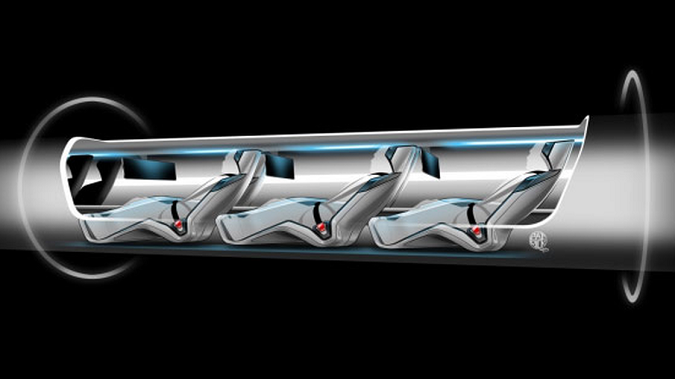A Closer Look At Elon Musk's Much-Hyped Hyperloop

You can thank brainy billionaire Elon Musk’s Hyperloop proposal for bringing electro-magnetic-powered transportation and the linear induction motor back into the public consciousness.
The Hyperloop is a system for really-really rapid transit. If built, Musk claims it can carry people about 800 miles per hour, which could get you from Los Angeles to San Francisco in about 30 minutes.
It would carry passengers in aluminum pods inside above-ground tubes. The system, as imagined, could carry people or cars. Bloomberg Businessweek explains:
Inside the tubes, the pods would be mounted on thin skis made out of inconel, a trusted alloy of SpaceX that can withstand high pressure and heat. Air gets pumped through little holes in the skis to make an air cushion, Musk says. The front of the pod would have a pair of air jet inlets—sort of like the Concorde.
An electric turbo compressor would compress the air from the nose and route it to the skis and to the cabin. Magnets on the skis, plus an electromagnetic pulse, would give the pod its initial thrust; reboosting motors along the route would keep the pod moving. And: no sonic boom. With warm air inside the tubes and high tailwinds, the pods could travel at high speeds without crossing the sound barrier. “The pod can go just below the speed of sound relative to the air,” Musk says.
So the vision combines the concepts behind pneumatic tubes, linear induction motors and magnetic levitation, but aren’t direct implementations of those technologies.
“Magnetic levitation has been proposed for many years,” says Mark Thompson, an electrical engineering professor at Worcester Polytechnic University, who earned his doctorate in magnetic levitation at Massachusetts Institute of Technology. “The Japanese built a prototype, the Chinese have a train that runs. It’s a new application for an older technology.”
Originally, Musk didn’t want to even develop or finance the Hyperloop, since Tesla and SpaceX are his top priorities. On a conference call to explain his design Monday, he signaled a change of heart.
“It would be cool to see a new form of transport happen,” Musk says. “I think it might help if I made a prototype and sort of helped get things going in that way.”
Linear induction motors are not new — Musk suggested we reporters “look it up” when asked about them. Before that, there was the original magnetic levitation, or maglev, concept. After James Powell and Gordon Danby invented the magnetic levitation train in 1968, it enjoyed some popularity in the U.S. By the early 1990s, former Sen. Daniel Patrick Moynihan made maglev a passion of his and worked it into the Intermodal Transportation Safety and Efficiency Act, which encouraged states to use federal money on non-highway modes of transportation.
Since then, American interest and investment in radically new transportation infrastructure has dried up. And it’s on policy grounds that former U.S.
Department of Transportation Assistant Secretary Emil Frankel has reservations.
“To talk about these kinds of leap-frogging technology in a context when we can’t really adequately maintain our existing infrastructure is really not terribly realistic. At least not in terms of the public policy debate,” Frankel tells NPR.
As for the Hyperloop, Thompson says the science behind it will likely work — there are just all kinds of open questions.
“The devil’s in the details in terms of testing, safety, passenger safety, egress, vibration, all that engineering stuff,” Thompson says.
Musk agrees, acknowledging that the road to making the Hyperloop a reality is paved with potential problems.
“The way these things tend to work is you start building a prototype and you start encountering a whole series of issues that you have to figure your way around,” Musk says.
Launching a capsule carrying humans in it down a tube will certainly require some testing. He estimates a prototype could take about two years, and building out a full system to cover 1,000 miles would take a decade.
You can return to the main Market News page, or press the Back button on your browser.

